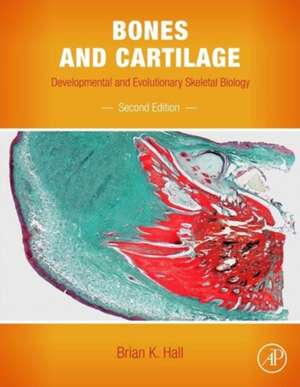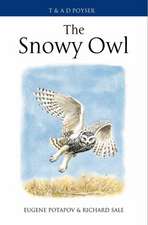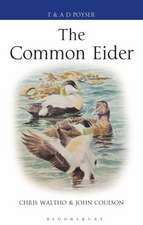Bones and Cartilage: Developmental and Evolutionary Skeletal Biology
Autor Brian K. Hallen Limba Engleză Hardback – 4 ian 2015
The second edition of Bones and Cartilage includes the most recent knowledge of molecular, cellular, developmental and evolutionary processes, which are integrated to outline a unified discipline of developmental and evolutionary skeletal biology. Additionally, coverage includes how the molecular and cellular aspects of bones and cartilage differ in different skeletal systems and across species, along with the latest studies and hypotheses of relationships between skeletal cells and the most recent information on coupling between osteocytes and osteoclasts All chapters have been revised and updated to include the latest research.
- Offers complete coverage of every aspect of bone and cartilage, with updated references and extensive illustrations
- Integrates development and evolution of the skeleton, as well a synthesis of differentiation, growth and patterning
- Treats all levels from molecular to clinical, embryos to evolution, and covers all vertebrates as well as invertebrate cartilages
- Includes new chapters on evolutionary skeletal biology that highlight normal variation and variability, and variation outside the norm (neomorphs, atavisms)
- Updates hypotheses on the origination of cartilage using new phylogenetic, cellular and genetic data
- Covers stem cells in embryos and adults, including mesenchymal stem cells and their use in genetic engineering of cartilage, and the concept of the stem cell niche
Preț: 601.15 lei
Preț vechi: 766.21 lei
-22% Nou
Puncte Express: 902
Preț estimativ în valută:
115.07€ • 125.03$ • 96.72£
115.07€ • 125.03$ • 96.72£
Carte tipărită la comandă
Livrare economică 14-28 aprilie
Preluare comenzi: 021 569.72.76
Specificații
ISBN-13: 9780124166783
ISBN-10: 0124166784
Pagini: 920
Ilustrații: illustrations
Dimensiuni: 216 x 276 x 48 mm
Greutate: 2.84 kg
Ediția:Revised
Editura: ELSEVIER SCIENCE
ISBN-10: 0124166784
Pagini: 920
Ilustrații: illustrations
Dimensiuni: 216 x 276 x 48 mm
Greutate: 2.84 kg
Ediția:Revised
Editura: ELSEVIER SCIENCE
Public țintă
Biologists, medical researchers, evolutionary biologists, paleontologists, skeletal biologists, endocrinologists as well as graduate students and clinicians in all of these areasCuprins
Part I Vertebrate Skeletal Tissues1. Vertebrate Skeletal Tissues2. Bone3. Vertebrate Cartilages
Part II Origins and Types of Skeletal Tissues4. Invertebrate Cartilages, Notochordal Cartilage and Cartilage Origins5. Intermediate Tissues6. Lessons from Fossils
Part III Unusual Modes of Skeletogenesis7. Horns and Ossicones8. Antlers9. Tendon Skeletogenesis and Sesamoids
Part IV Stem and Progenitor Cells10. Embryonic Stem and Progenitor Cells11. Stem and Progenitor Cells in Adults
Part V Skeletogenic Cells12. Bipotential Osteochondroprogenitor Cells13. Dedifferentiation of Chondrocytes and Endochondral Ossification14. Dedifferentiation and Stem Cells: Regeneration of Urodele Limbs and Mammalian Fingertips15. Cells to Make and Cells to Break
Part VI Embryonic Origins16. Skeletal Origins: Somitic Mesoderm, Vertebrae, Pectoral and Pelvic Girdles17. Skeletal Origins: Neural Crest Cells18. Epithelial–Mesenchymal Interactions initiate Skeletogenesis
Part VII Getting Started19. The Membranous Skeleton: Condensations20. From Condensation to Differentiation21. Skulls, Eyes and Ears: Condensations and Tissue Interactions
Part VIII Similarity and Diversity22. Hondrocyte Diversity23. Cartilage Diversity24. Osteoblast and Osteocyte Diversity and Osteogenesis in vitro25. Diversity of Bone as a Tissue and as an Organ
Part IX Maintaining Cartilage in Good Times and in Bad26. Maintaining Differentiated Chondrocytes through Cell–Matrix Interactions27. Maintenance Awry – Chondrodysplasias and Achondroplasia28. Restarting Mammalian Articular Chondrocytes29. Repair of Fractures and Regeneration of Growth Plates
Part X Growing Together and Growing Apart30. Initiating Skeletal Growth31. Growth and Morphogenesis of Long Bones32. Long Bone Growth: A Case of Crying Wolf?
Part XI Staying Apart33. The Temporomandibular Joint and Cranial Synchondroses34. Sutures and Craniosynostosis
Part XII Limb Buds35. The Mesodermal Limb Field and the Apical Epithelial Ridge36. Adding or Deleting an Apical Epithelial Ridge37. Limb Buds in Limbed and Limbless Tetrapods
Part XIII Limbs and Limb Skeletons38. Axes and Polarity of Limb Buds and Limbs39. Patterning and Shaping Limb Buds and Limb Skeletons40. Before Limbs There Were Fins
Part XIV Backbones and Tails41. Vertebral Chondrogenesis: Cell Differentiation and Morphogenesis42. Relationships between Notochord and Vertebral Cartilage43. Tail Buds, Tails and Taillessness
Part XV Evolutionary Skeletal Biology44. Variation45. Variation Outside the Norm: Neomorphs and Atavisms
Part II Origins and Types of Skeletal Tissues4. Invertebrate Cartilages, Notochordal Cartilage and Cartilage Origins5. Intermediate Tissues6. Lessons from Fossils
Part III Unusual Modes of Skeletogenesis7. Horns and Ossicones8. Antlers9. Tendon Skeletogenesis and Sesamoids
Part IV Stem and Progenitor Cells10. Embryonic Stem and Progenitor Cells11. Stem and Progenitor Cells in Adults
Part V Skeletogenic Cells12. Bipotential Osteochondroprogenitor Cells13. Dedifferentiation of Chondrocytes and Endochondral Ossification14. Dedifferentiation and Stem Cells: Regeneration of Urodele Limbs and Mammalian Fingertips15. Cells to Make and Cells to Break
Part VI Embryonic Origins16. Skeletal Origins: Somitic Mesoderm, Vertebrae, Pectoral and Pelvic Girdles17. Skeletal Origins: Neural Crest Cells18. Epithelial–Mesenchymal Interactions initiate Skeletogenesis
Part VII Getting Started19. The Membranous Skeleton: Condensations20. From Condensation to Differentiation21. Skulls, Eyes and Ears: Condensations and Tissue Interactions
Part VIII Similarity and Diversity22. Hondrocyte Diversity23. Cartilage Diversity24. Osteoblast and Osteocyte Diversity and Osteogenesis in vitro25. Diversity of Bone as a Tissue and as an Organ
Part IX Maintaining Cartilage in Good Times and in Bad26. Maintaining Differentiated Chondrocytes through Cell–Matrix Interactions27. Maintenance Awry – Chondrodysplasias and Achondroplasia28. Restarting Mammalian Articular Chondrocytes29. Repair of Fractures and Regeneration of Growth Plates
Part X Growing Together and Growing Apart30. Initiating Skeletal Growth31. Growth and Morphogenesis of Long Bones32. Long Bone Growth: A Case of Crying Wolf?
Part XI Staying Apart33. The Temporomandibular Joint and Cranial Synchondroses34. Sutures and Craniosynostosis
Part XII Limb Buds35. The Mesodermal Limb Field and the Apical Epithelial Ridge36. Adding or Deleting an Apical Epithelial Ridge37. Limb Buds in Limbed and Limbless Tetrapods
Part XIII Limbs and Limb Skeletons38. Axes and Polarity of Limb Buds and Limbs39. Patterning and Shaping Limb Buds and Limb Skeletons40. Before Limbs There Were Fins
Part XIV Backbones and Tails41. Vertebral Chondrogenesis: Cell Differentiation and Morphogenesis42. Relationships between Notochord and Vertebral Cartilage43. Tail Buds, Tails and Taillessness
Part XV Evolutionary Skeletal Biology44. Variation45. Variation Outside the Norm: Neomorphs and Atavisms
Recenzii
"...gives an updated impressive overview that integrates development and evolution of the skeleton and covers of a tremendous wealth of various topics...An impressive achievement that sets standards." --Bulletin of Fish Biology
"I would recommend this book for all graduate students in the health sciences, and as a dentist I would specifically recommend it to the dental specialties: orthodontists, endodontists, oral surgeons, periodontists, and oral pathologists. The information is presented in a clear concise manner with ample figures and extensive references. As a practicing periodontist with over 30 years of experience, I have found this book both useful and engaging. It now has a prominent position among my desk reference books. It is one that I will visit on a regular and frequent basis." --William Stenberg, DDS, MS, MPH, Diplomate of the American Board of Periodontology Rockmore-King Clinic Kodiak, AK, USA
"This is the book that will set the standard for the field for decades to come. It covers everything from the elementary to the highly sophisticated and the obscure detail. This is a great resource!" –Gunter Wagner, Professor of Ecology and Evolutionary Biology, Yale University
"I would recommend this book for all graduate students in the health sciences, and as a dentist I would specifically recommend it to the dental specialties: orthodontists, endodontists, oral surgeons, periodontists, and oral pathologists. The information is presented in a clear concise manner with ample figures and extensive references. As a practicing periodontist with over 30 years of experience, I have found this book both useful and engaging. It now has a prominent position among my desk reference books. It is one that I will visit on a regular and frequent basis." --William Stenberg, DDS, MS, MPH, Diplomate of the American Board of Periodontology Rockmore-King Clinic Kodiak, AK, USA
"This is the book that will set the standard for the field for decades to come. It covers everything from the elementary to the highly sophisticated and the obscure detail. This is a great resource!" –Gunter Wagner, Professor of Ecology and Evolutionary Biology, Yale University









